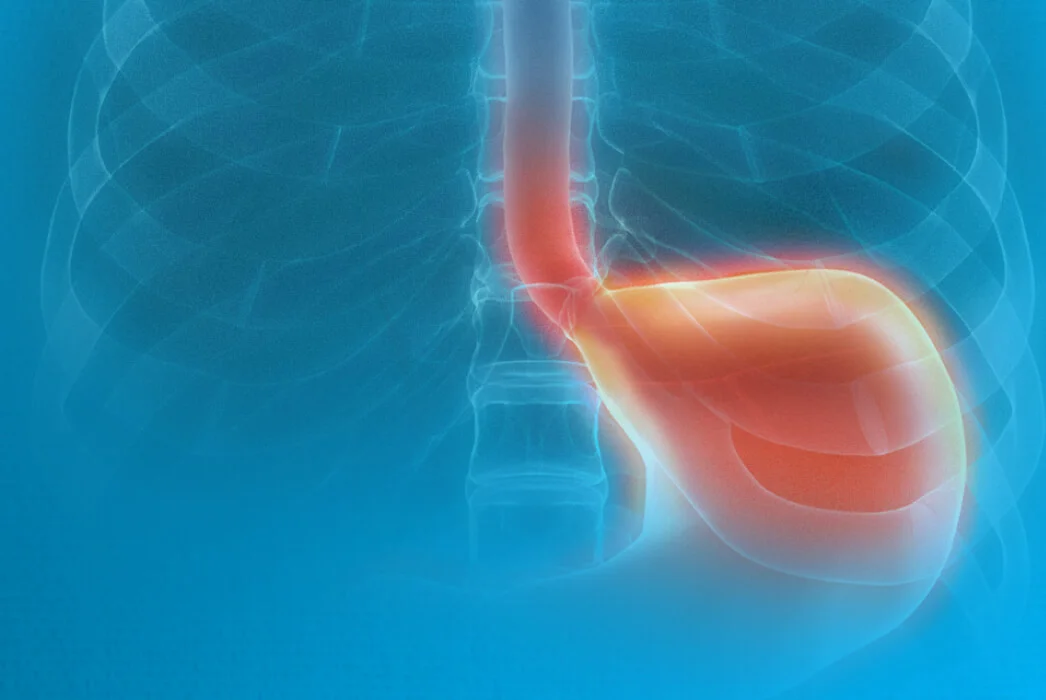Understanding Barrett's Esophagus and Cancer Risk
[.text-color-brand-blue][#tip-1]Barrett’s esophagus[#tip-1][.text-color-brand-blue] is a condition where the lining of the [.text-color-brand-blue][#tip-2]esophagus[#tip-2][.text-color-brand-blue] changes to resemble the lining of the intestine, often as a result of acid reflux. Esophageal tissue can be damaged by acid repeatedly flowing from the stomach back into the esophagus, which is the tube that carries food from the mouth to the stomach. In Barrett’s esophagus, damage to normal esophagus cells is repaired with cells normally found in the intestine, which are more resistant to acid damage. The change from one cell type to another is called [.text-color-brand-blue][#tip-3]metaplasia[#tip-3][.text-color-brand-blue]. Accumulated damage to the esophagus can also result in abnormal cell growth ([.text-color-brand-blue][#tip-4]dysplasia[#tip-4][.text-color-brand-blue]) which may progress to esophageal cancer. Often, Barrett’s esophagus is a complication of long-standing [.text-color-brand-blue][#tip-5]gastroesophageal reflux disease[#tip-5][.text-color-brand-blue] (GERD), where the backflow of stomach acid occurs chronically.
.jpg)
Barrett’s esophagus symptoms and risk

Barrett’s esophagus is considered a precancerous condition, because it can progress into esophageal adenocarcinoma, commonly known as esophageal cancer.
An estimated 5% of people with Barrett’s esophagus will develop esophageal cancer over the course of their lifetime. While the chances of Barrett's esophagus becoming cancer are relatively low, the consequences of developing esophageal cancer are very high. The cancer is highly lethal after symptom onset, with less than 20% of patients surviving beyond five years.
Barrett’s esophagus is the only known precursor to [.text-color-brand-blue][#tip-6]esophageal adenocarcinoma[#tip-6][.text-color-brand-blue], and unlike esophageal cancer, Barrett's esophagus is highly curable and treatment is minimally invasive.
Because of this, the primary method of preventing esophageal adenocarcinoma is screening for Barrett’s esophagus and treating [.text-color-brand-blue][#tip-7]precancerous[#tip-7][.text-color-brand-blue] tissue before it can progress to cancer.


There are no symptoms specific to Barrett’s esophagus. However, Barrett’s esophagus patients may experience GERD symptoms, which include heartburn, indigestion, difficulty in swallowing solid foods and nocturnal regurgitation.

Barrett's esophagus occurs in approximately 5.6% of the general U.S population. The underlying reason why some people develop Barrett’s esophagus while others do not is unknown. However, people with specific risk factors are more likely to develop Barrett’s esophagus than others.

Who should be screened for Barrett’s esophagus?
Because Barrett’s esophagushas no symptoms, most patients screened for the condition have long-standing GERD and multiple risk factors. As of 2022, the American Gastroenterological Association’s Clinical Practice Updates (CPU) (Muthusamy et al., 2022)recommend screening if patients have just three risk factors. The updates no longer require that patients have long-standing GERD.
Barrett’s esophagus symptoms and risk
Having multiple risk factors for Barrett's esophagus increases an individual's overall risk.
For example, having long-standing GERD, plus any additional risk factors,
increases the likelihood of developing Barrett’s esophagus from 3% to 12%.
| Risk factors | |
|---|---|
| Long-standing GERD | Risk is highest for those with frequent, long-standing GERD, who don’t respond to treatment with proton-pump inhibitor medication intended to reduce acid reflux |
| Being male | Barrett’s esophagus occurs three times more often in men than in women |
| Being white | Barrett’s esophagus is most common in white populations, less common in Hispanic populations, and uncommon in Asian and Black populations. |
| Being over 50 | The risk of Barrett’s esophagus increases with age. The average age at diagnosis is 55 years. |
| Obesity | Risk is highest for those with a lot of abdominal fat |
| Tobacco and alcohol | The more a person uses tobacco or alcohol and the longer it is used, the higher the cancer risk. |
| Family history | A family history of Barrett’s esophagus or esophageal adenocarcinoma in first-degree relatives increases the risk of developing Barrett’s esophagus. Research into genetic risk factors contributing to risk of Barrett’s esophagus are ongoing. |
| Hiatal hernia | Risk of Barrett’s esophagus is higher for those with a hiatal hernia. A hiatal hernia causes the upper portion of the stomach to bulge into the chest cavity through an opening in the diaphragm — the muscular wall that separates the chest and abdomen |
Barrett’s esophagus screening
Screening for Barrett’s esophagus makes it possible to detect and treat dysplastic tissue before it can progress to esophageal cancer. Screening for Barrett's esophagus requires conducting an upper endoscopy. During this procedure, a clinician examines the entire length of the esophagus with a tool called an [.text-color-brand-blue][#tip-8]endoscope[#tip-8][.text-color-brand-blue] to look for changes in the esophageal tissue’s appearance. They also take small samples of esophageal tissue, called biopsies, which are closely examined for signs of dysplasia and to confirm a diagnosis of Barrett’s esophagus.

Assessing the risk that Barrett’s esophagus will progress to cancer
Barrett’s esophagus is thought to progress sequentially from a change in cell type to abnormal cell growth and then to cancer. The abnormal changes in cell growth are called dysplasia. Detecting and treating dysplastic Barrett’s esophagus is an extremely effective way to prevent esophageal adenocarcinoma. However, only treating patients who present with dysplastic Barrett’s esophagus can result in missing patients who progress to cancer rapidly. In fact, 50% of Barrett’s esophagus patients who develop cancer were initially treated as if they were low risk because no dysplasia was detected at diagnosis.
Clinicians can better identify who is at risk of cancer progression following Barrett’s esophagus screening by identifying [.text-color-brand-blue][#tip-9]molecular changes[#tip-9][.text-color-brand-blue] that precede visible ones. TissueCypher is an artificial intelligence-driven, precision medicine test to predict the [.text-color-brand-blue][#tip-10]risk of progression[#tip-10][.text-color-brand-blue] from Barrett’s esophagus to cancer, which can identify patients that show no signs of dysplasia but are at high risk of progressing to cancer in the future.
Learn more about how TissueCypher
informs cancer progression risk








